#scientific studies and research center
Explore tagged Tumblr posts
Text
making an astronomy/meteoritics iterator oc when i know fuckall or at least just very basic things about those things was maybe a mistake. Looking up stuff for reference/inspo like haha i like your funny words magic man
#currently trying to figure out if it could work to make them be built in the center of an impact crater#there is one in canada that has a circular lake i might just steal that#still thinking about what even their deal is and what exactly they do.#they probably studied the rocks n minerals in the crater if their creators havent done that extensively already#and analyse any other material brought to them?#i think they would also do stuff about planets n such they observe their cycles/routes or something like that#I dont think they'd be puuuurely scientific i think there would be a lot of religious or spiritual stuff too#they dont just do the science bits but also how it would/could connect to spirituality and such#they are really really old even by iterator standards so sometimes their theories and research can be a bit outdated#“no stones this spiritual theory is wayyy outdated you cant base your calculations on that. No we will not start working with it again -#-just because you refuse to switch to the new model. Stones please we had this discussion already just give me the star charts i requested"#something like that#carpsounds
29 notes
·
View notes
Text
As my following grows and as I meet more and more people who have rats, had rats, know someone who has/had rats, and love rats...
increasingly I wonder if/when a day will come... a day that I'll express rat enjoyment to someone and they'll enthusiastically ask me if I've heard of This Funnie Little Rodent Blog they like, figuring I may already know it or will enjoy it if not...
and it's.. my blog... and then I have to come out as popular Rat Tumblr blogger that they follow and now know IRL.......
#/lh#I'm saying this like it's some big deal but I'm just exaggerating for comedic effect adjfgsbkdfj#no idea what the likelihood on that looks like. based on statistics of people estimating statistics? probably likelier than we all think#anyway that time I posted a survey for a university research project here and you all wound up comprising 2/3 of our sample was so funny#I had to actually say in an academic research paper that one possible flaw in our study#was bias that may result from 2/3 the sample having come from a niche and extremely specific demographic of people#due to the fact that they flocked in from One Of The Researchers' Substantial Online Following Centered Around A Particular Theme#And Selected Specifically To Have Only A Certain Kind Of Person On It Via Boundaries And Blocking#literally you all made up 98/150 respondents (but that's assuming all digital responses were from y'all-- we had 52 paper responses)#ah but the research symposium was the best. in the paper I was able to remain that generic about it#but at the research symposium. well it's a glorified science fair. so participants have their own stations set up and observers tour them#as the participants speak to their audience; directly providing a summary and then answering any questions#some of the audience/observers are faculty and most are fellow students#so real scholarly scientific types yeah? so they had questions. thoughtful questions#long story short I confessed to numerous listeners throughout the day that the sample's bizarre gender ratio is probably my fault#around 57% women; 21% nonbinary adults; 17% men-- an unusual proportion#so I had to academically tell my professors... underclassmen..... my classmates....... acquaintances.... foes..........#... that I'm big famous in Rat#and it was so. djkjSBCJXHQKRIGAJFSHF
35 notes
·
View notes
Text
why dont you go listen to the instrumentals for Reckless Battery Burns and End-World Normopathy for 17 consecutive hours and maybe youll calm down
#am not calming down instead im writing immoral alien scientific studies at the same intensity#i love cyjlia shes such a girlboss for doing unethical telepathic brain center research#yes girl permanently ruin hundreds of lives!!!! slay#skelerants
0 notes
Text
Understanding the theory’s ascent from fringe forums to scientific journals to the halls of Congress helps clarify some of the moral panic and pernicious logic employed to restrict the autonomy and rights of trans people today. It also serves as a vivid example of how questionable science can be weaponized to achieve political goals.
A number of studies on trans youth have taken on “misinformational afterlives,” says TJ Billard, an assistant professor of communications at Northwestern University and executive director of the Center for Applied Transgender Studies. Among them are four papers published between 2008 and 2013 that have together been used to claim that most children “grow out” of gender dysphoria and opt not to transition. All have been shown to have numerous shortcomings. In some, nearly 40% of young people surveyed did not meet the criteria for the official gender dysphoria diagnosis in the Diagnostic and Statistical Manual of Mental Disorders edition used at the time. In two, researchers classified some subjects as having detransitioned—or reversed their transition—purely on the basis of whether a parent or third party said it happened. A 2018 study found that three of the papers labeled those who had stopped responding to researchers as detransitioners; and in one, a subject who identified as nonbinary was classified as detransitioning.
“There’s a wealth of bad science that is out there, and this science doesn’t stay in journals,” Billard says. Parents unfamiliar with trans issues, who don’t understand gender-affirming health care and don’t have the expertise to read the studies themselves, often fall under its sway.
... When Littman took up the question, she decided to survey parents, who she felt would be easier to reach than trans youths themselves. In her Methods section, she writes that “to maximize the chances of finding cases meeting eligibility criteria”—meaning youths who suddenly became gender dysphoric, according to their parents—she turned to three websites: 4thwavenow.com, a “community of people who question the medicalization of gender-atypical youth”; transgendertrend.com, which says it’s concerned about “the unprecedented number of teenage girls suddenly self-identifying as ‘trans’”; and youthtranscriticalprofessionals.org, a now-private website that was “concerned about the current trend to quickly diagnose and affirm young people as transgender.”
The results were in line with what one might expect given those sources: 76.5% of parents surveyed “believed their child was incorrect in their belief of being transgender.” More than 85% said their child had increased their internet use and/or had trans friends before identifying as trans. The youths themselves had no say in the study, and there’s no telling if they had simply kept their parents in the dark for months or years before coming out. (Littman acknowledges that “parent-child conflict may also explain some of the findings.”)
Arjee Restar, now an assistant professor of epidemiology at the University of Washington, didn’t mince words in her 2020 methodological critique of the paper. Restar noted that Littman chose to describe the “social and peer contagion” hypothesis in the consent document she shared with parents, opening the door for biases in who chose to respond to the survey and how they did so. She also highlighted that Littman asked parents to offer “diagnoses” of their child’s gender dysphoria, which they were unqualified to do without professional training. It’s even possible that Littman’s data could contain multiple responses from the same parent .... But politics is blind to nuances in methodology. And the paper was quickly seized by those who were already pushing back against increasing acceptance of trans people. ... Many people who are citing Littman’s work probably haven’t even read the study or seen the correction, Billard says: “People are citing a Reddit post in which somebody invoked the idea of Littman and her research.” Littman agrees with this characterization. “It boggles my mind how people are comfortable holding forth on topics that they haven’t actually read papers [about],” she says.
... Lawmakers in more than 25 states have introduced anti-trans bills during 2022 legislative sessions. Politicians writing such legislation have plenty of questionable studies, partisan doctors, and associations that lobby against transgender rights to draw on. Littman’s ROGD study is often a go-to. The Coalition for the Advancement & Application of Psychological Science wrote in 2021 that many of the “over 100 bills under consideration in legislative bodies across the country that seek to limit the rights of transgender adolescents” are “predicated on the unsupported claims advanced by ROGD.”
2K notes
·
View notes
Text
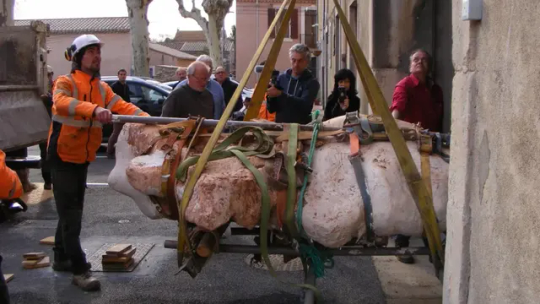
A 70 Million-Year-Old Titanosaur Dinosaur Skeleton Found in France
A chance discovery made in southern France has revealed a rare specimen — an almost complete dinosaur skeleton found connected from its hind skull to its tail.
The massive fossil came to light in May 2022, after now 25-year-old amateur paleontologist Damien Boschetto and his dog stumbled across something unusual while walking in a forest in Montouliers, France. Boschetto had noticed a cliff edge that had recently collapsed and decided to take a closer look, when he spotted an exposed bone sticking out of the ground, local media outlet France Bleu first reported on February 13.
The Archaeological and Paleontological Cultural Association at the Cruzy Museum, in collaboration with the French National Center for Scientific Research, identified the nearly 10-meter-long (32.8-foot-long) fossil as a Titanosaur skeleton upon excavation. Boschetto, who has been a member of the association for eight years, said that while unearthing dinosaur remains is “always exciting and interesting for scientific research and the understanding of the ecosystems of that time,” finding the bones in their almost original anatomical position is what makes this find extraordinary.
“From a museography point of view, it will make it possible to present to the general public animals almost complete in anatomical positions, which is something great,” Boschetto added via email.
A group of history and archaeology enthusiasts created the Archaeological and Paleontological Cultural Association in 1975 to safeguard the heritage around the village of Cruzy, with several members becoming enlightened amateurs in paleontology due to the areas’ wealth of dinosaur fossils, said Jean-Marc Veyssières, a member of the group and one of the fossil preparers for this discovery. Today, the association is made up of inhabitants of the region, including a few scientists as well as students.
“The most exciting thing was to realize that we had at least one anatomically connected animal and that it was a titanosaur, a long-necked dinosaur,” said Veyssières in an email. “(Boschetto) is an enlightened enthusiast and curious about nature, he spends a lot of time surveying the region in search of new areas. … He became an expert on the Late Cretaceous fauna of our region.”
The association has been excavating the site, which Boschetto referred to as a bone bed, a term used by paleontologists to describe a dense area of animal bones and other fossilized remains, for the past two years. And the newly announced find was not Boschetto’s first.
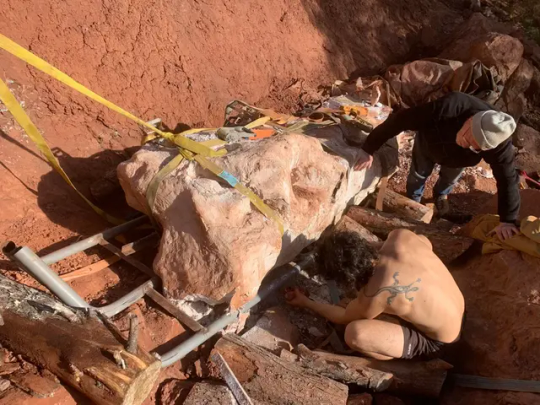
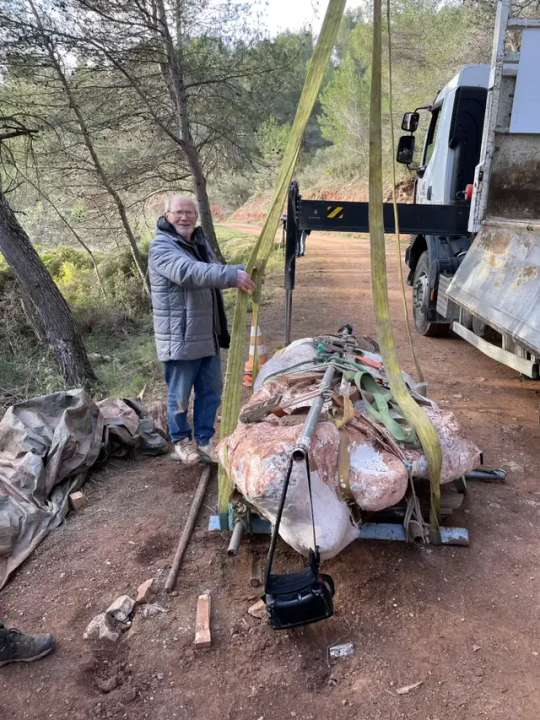
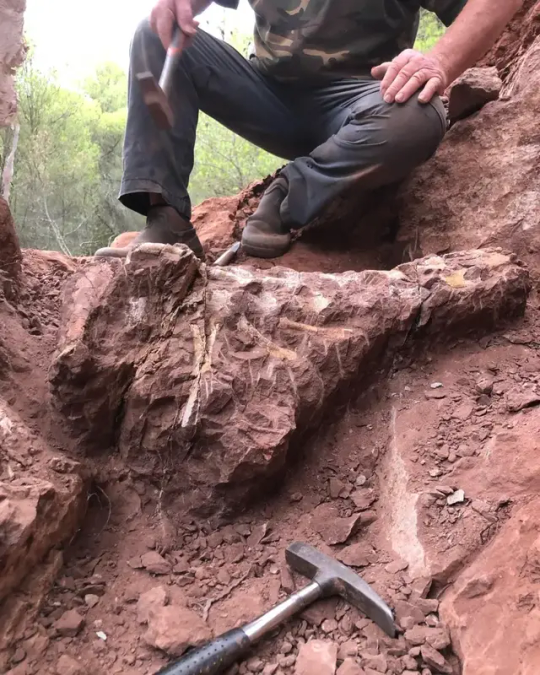
The recently revealed 70% complete Titanosaur skeleton was retrieved during the excavation along with several fossils of various dinosaurs and other vertebrates, including some in anatomical connection and near complete. Other remains identified included those of a Rhabdodon — a herbivore, or plant-eater, like the Titanosaur — and fragments from skeletons of carnivores such as Theropods and crocodiles, according to Boschetto.
The Titanosaur skeleton currently resides in the Cruzy Museum’s laboratory, where it will be further studied, Veyssières said.
Titanosaur found intact
Researchers estimated the age of the newly discovered fossil to be around 70 to 72 million years old, but Titanosaurs roamed around on four legs from the Late Jurassic Epoch to the end of the Cretaceous Period, approximately 163.5 million to 66 million years ago. Titanosaurs belong to a larger group of dinosaurs known as sauropods, a family of long-necked herbivores that were some of the largest dinosaurs of their time, according to Britannica.
Remains of Titanosaur fossils are widely unearthed in Europe, but few are discovered in anatomical connection, Boschetto said. Finding a skeleton in this connected state suggests that the body was buried before it had entirely decomposed, leaving “some tissues connecting the bones to one another,” said Matthew Carrano, research geologist and curator of Dinosauria at the Smithsonian Institution National Museum of Natural History.


The completeness of the specimen will “make it easier to determine whether it’s a new species or a new specimen of a species that’s already known,” Carrano said in an email. “It will take time to learn all the details about this new specimen, but I’m sure it will provide important new information about this group of dinosaurs.”
The region in which Boschetto discovered the specimen is known to be rich in fossils of dinosaurs and other species living at the same time and is “building one of the largest collections of dinosaurs from the Upper Cretaceous in France,” he said. The association did not publicize the discovery until excavation was complete to protect the archaeological site, he added.
The association plans to continue research on the fossils and to further search the area, and the group’s members hope to obtain the funds to “create a large-scale museum that can accommodate and present these collections,” Boschetto said.
By Taylor Nicioli.



#A 70 Million-Year-Old Titanosaur Dinosaur Skeleton Found in France#Montouliers France#paleontologist#dinosaurs#fossils#ancient artifacts#archeology#archeolgst#history#history news#ancient history
400 notes
·
View notes
Text
also preserved on our archive
by Rowan Walrath
Public and private funding is lacking, scrambling opportunities to develop treatments
In brief Long COVID is a difficult therapeutic area to work in. It’s a scientifically challenging condition, but perhaps more critically, few want to fund new treatments. Private investors, Big Pharma, and government agencies alike see long COVID as too risky as long as its underlying mechanisms are so poorly understood. This dynamic has hampered the few biotechnology and pharmaceutical companies trying to develop new medicines. The lack of funding has frustrated people with long COVID, who have few options available to them. And crucially, it has snarled research and development, cutting drug development short.
When COVID-19 hit, the biotechnology company Aim ImmunoTech was developing a drug for myalgic encephalomyelitis/chronic fatigue syndrome, better known as ME/CFS. As more people came down with COVID-19, some began to describe lingering problems that sounded a lot like ME/CFS. In many cases, people who got sick simply never seemed to get better. In others, they recovered completely—or thought they had—only to be waylaid by new problems: fatigue that wouldn’t go away with any amount of rest, brain fog that got in the way of normal conversations, a sudden tendency toward dizziness and fainting, or all the above.
There was a clear overlap between the condition, which patients began calling long COVID, and ME/CFS. People with ME/CFS have a deep, debilitating fatigue. They cannot tolerate much, if any, exercise; walking up a slight incline can mean days of recovery. Those with the most severe cases are bedbound.
Aim’s leaders set out to test whether the company’s drug, Ampligen, which is approved for ME/CFS in Argentina but not yet in the US, might be a good fit for treating long COVID. They started with a tiny study, just 4 people. When most of those participants responded well, they scaled up to 80. While initial data were mixed, people taking Ampligen were generally able to walk farther in a 6 min walk test than those who took a placebo, indicating improvement in baseline fatigue. The company is now making plans for a follow-on study in long COVID.
Aim’s motivation for testing Ampligen in long COVID was twofold. Executives believed they could help people with the condition, given the significant overlap in symptoms with ME/CFS. But they also, plainly, thought there’d be money. They were wrong.
“When we first went out to do this study in long COVID, there was money from . . . RECOVER,” Aim scientific officer Chris McAleer says, referring to Researching COVID to Enhance Recovery (RECOVER), the National Institutes of Health’s $1.7 billion initiative to fund projects investigating causes of, and potential treatments for, long COVID. McAleer says Aim attempted to get RECOVER funds, “believing that we had a therapeutic for these individuals, and we get nothing.”
Instead of funding novel medicines like Ampligen, the NIH has directed most of its RECOVER resources to observational studies designed to learn more about the condition, not treat it. Only last year did the agency begin to fund clinical trials for long COVID treatments, and those investigate the repurposing of approved drugs. What RECOVER is not doing is funding new compounds.
RECOVER is the only federal funding mechanism aimed at long COVID research. Other initiatives, like the $5 billion Project NextGen and the $577 million Antiviral Drug Discovery (AViDD) Centers for Pathogens of Pandemic Concern, put grant money toward next-generation vaccines, monoclonal antibodies, and antivirals for COVID-19. They stop short of testing those compounds as long COVID treatments.
Private funding is even harder to come by. Large pharmaceutical companies have mostly stayed away from the condition. (Some RECOVER trials are testing Pfizer’s COVID-19 antiviral Paxlovid, but a Pfizer spokesperson confirms that Pfizer is not sponsoring those studies.) Most investors have also avoided long COVID: a senior analyst on PitchBook’s biotech team, which tracks industry financing closely, says he isn’t aware of any investment in the space.
“What you need is innovation on this front that’s not driven by profit motive, but impact on global human health,” says Sumit Chanda, an immunologist and microbiologist at Scripps Research who coleads one of the AViDD centers. “We could have been filling in the gaps for things like long COVID, where pharma doesn’t see that there’s a billion-dollar market.”
The few biotech companies that are developing potential treatments for long COVID, including Aim, are usually funding those efforts out of their own balance sheets. Experts warn that such a pattern is not sustainable. At least four companies that were developing long COVID treatments have shut down because of an apparent lack of finances. Others are evaluating a shift away from long COVID.
“It is seen by the industry and by investors as a shot in the dark,” says Radu Pislariu, cofounder and CEO of Laurent Pharmaceuticals, a start-up that’s developing an antiviral and anti-inflammatory for long COVID. “What I know is that nobody wants to hear about COVID. When you say the name COVID, it’s bad . . ., but long COVID is not going anywhere, because COVID-19 is endemic. It will stay. At some point, everyone will realize that we have to do more for it.”
‘Time and patience and money’ Much of the hesitancy to make new medicines stems from the evasive nature of long COVID itself. The condition is multisystemic, affecting the brain, heart, endocrine network, immune system, reproductive organs, and gastrointestinal tract. While researchers are finding increasing evidence for some of the disease’s mechanisms, like viral persistence, immune dysregulation, and mitochondrial dysfunction, they might not uncover a one-size-fits-all treatment.
“Until we have a better understanding of the underlying mechanisms of long COVID, I think physicians are doing the best they can with the information they have and the guidance that is available to them,” says Ian Simon, director of the US Department of Health and Human Services’ Office of Long COVID Research and Practice. The research taking place now will eventually guide new therapeutic development, he says.
Meanwhile, time marches on.
By the end of 2023, more than 409 million people worldwide had long COVID, according to a recent review coauthored by two cofounders of the Patient-Led Research Collaborative (PLRC) and several prominent long COVID researchers (Nat. Med. 2024; DOI: 10.1038/s41591-024-03173-6). Most of those 409 million contracted COVID-19 and then long COVID after vaccines and antivirals became available. That fact undercuts the notion that the condition results only from severe cases of COVID-19 contracted before those interventions existed. (Vaccination and treatment with antivirals do correlate with a lower incidence of long COVID but don’t prevent it outright.)
“There is that narrative that long COVID is over,” says Hannah Davis, cofounder of the PLRC and a coauthor of the review, who has had long COVID since 2020. “I think that’s fairly obviously not true.”
The few biotech companies that have taken matters into their own hands, like Aim, are often reduced to small study sizes with limited time frames because they can’t get outside funding.
InflammX Therapeutics, a Florida-based ophthalmology firm headed by former Bausch & Lomb executive Brian Levy, started testing an anti-inflammatory drug candidate called Xiflam after Levy’s daughter came down with long COVID. Xiflam is designed to close connexin 43 (Cx43) hemichannels when they become pathological. The hemichannels, which form in cell membranes, would otherwise allow intracellular adenosine triphosphate (ATP) to escape and signal the NLRP3 inflammasome to crank up its activity, causing pain and inflammation.
InflammX originally conceived of Xiflam as a treatment for inflammation in various eye disorders, but after Levy familiarized himself with the literature on long COVID, he figured the compound might be useful for people like his daughter.
InflammX set up a small Phase 2a study at a site just outside Boston. The trial will enroll just 20 participants, including Levy’s daughter and InflammX’s chief operating and financial officer, David Pool, who also has long COVID. The study is set up such that participants don’t know if they’re taking Xiflam or a placebo.
Levy says the company tried to communicate with NIH RECOVER staff multiple times but never heard back. “We couldn’t wait,” he says.
Larger firms are similarly disconnected from US federal efforts. COVID-19 vaccine maker Moderna appointed a vice president of long COVID last year. Bishoy Rizkalla now oversees a small team studying how the company’s messenger RNA shots could mitigate problems caused by new and latent viruses, including SARS-CoV-2. But Rizkalla says Moderna has no federally funded projects in long COVID.
Federal bureaucracy has slowed down research in other ways. When long COVID appeared, Tonix Pharmaceuticals was developing a possible drug called TNX-102 SL to treat fibromyalgia. The two conditions look similar: they’re painful, fatiguing, and multisystemic, and fibromyalgia can crop up after a viral infection.
But it wasn’t easy to design a study to test the compound in long COVID. Among other issues, the US Food and Drug Administration initially insisted that participants have a positive COVID-19 test confirmed by a laboratory, like a polymerase chain reaction test, to be included in the study. At-home diagnostics wouldn’t count.
“We spent a huge amount of money, and we couldn’t enroll people who had lab-confirmed COVID because no one was going to labs to confirm their COVID,” cofounder and CEO Seth Lederman says. “We just ran out of time and patience and money, frankly.”
Tonix had planned to enroll 450 participants. The company ultimately enrolled only 63. The study failed to meet its primary end point of reducing pain intensity, a result Lederman attributes to the smaller-than-expected sample size.
TNX-102 SL trended toward improvements in fatigue and other areas, like sleep quality and cognitive function, but Tonix is moving away from developing the compound as a long COVID treatment and focusing on developing it for fibromyalgia. If it’s approved, Lederman hopes that physicians will prescribe it to people who meet the clinical criteria for fibromyalgia regardless of whether their condition stems from COVID-19.
“I’m not saying we’re not going to do another study in long COVID, but for the short term, it’s deemphasized,” Lederman says.
Abandoned attempts Without more public or private investment, it’s unclear how research can proceed. The small corner of the private sector that has endeavored to take on long COVID is slowly becoming a graveyard.
Axcella Therapeutics made a big gamble in late 2022. The company pivoted from trying to treat nonalcoholic steatohepatitis, a liver disease, to addressing chronic fatigue in people with long COVID. In doing so, Axcella reoriented itself exclusively around long COVID, laying off most of its staff and abandoning other research activities. People in a 41-person Phase 2a trial of the drug candidate, AXA1125, showed improvement in fatigue scores based on a clinical questionnaire (eClinicalMedicine 2023, DOI: 10.1016/j.eclinm.2023.101946), but Axcella shut down before it could get its planned 300-person follow-on study up and running.
The fate of AXA1125 may be to gather dust. Axcella’s former executives have moved on to other pursuits. Erstwhile chief medical officer Margaret Koziel, once a champion of AXA1125, says by email that she is “not up to date on current research on long COVID.” Staff at the University of Oxford, which ran the Phase 2a study, were not able to procure information about the planned Phase 2b/3 trial. A spokesperson for Flagship Pioneering, the venture firm that founded Axcella in 2011, declined to comment to C&EN.
Other firms have met similar ends. Ampio Pharmaceuticals dissolved in August after completing only a Phase 1 study to evaluate an inhaled medication called Ampion in people with long COVID who have breathing issues. Biotech firm SolAeroMed shut down before even starting a trial of its bronchodilating medicine for people with long COVID. “Unfortunately we were unable to attract funding to support our clinical work for COVID,” CEO John Dennis says by email.
Another biotech company, Aerium Therapeutics, did manage to get just enough of its monoclonal antibody AER002 manufactured and in the hands of researchers at the University of California, San Francisco, before it ended operations. The researchers are now testing AER002 in a Phase 2 trial with people with long COVID. Michael Peluso, an infectious disease clinician and researcher at UCSF and principal investigator of the trial, says that while AER002 may not advance without a company behind it, the study could be valuable for validating long COVID’s mechanisms of disease and providing a proof of concept for monoclonal antibody treatment more generally.
“[Aerium] put a lot of effort into making sure that the study would not be impacted,” Peluso says. “Regardless of the results of this study, doing a follow-up study now that we’ve kind of learned the mechanics of it with modern monoclonals would be really, really interesting.”
‘A squandered opportunity’ In 2022, the NIH’s National Institute of Allergy and Infectious Diseases (NIAID) put about $577 million toward nine research centers that would discover and develop antivirals for various pathogens. Called the Antiviral Drug Discovery (AViDD) Centers for Pathogens of Pandemic Concern, the centers were initially imagined as 5-year projects, enough time to ready multiple candidates for preclinical development. The NIH allocated money for the first 3 years and promised more funds to come later.
The prospect excited John Chodera, a computational chemist at the Memorial Sloan Kettering Cancer Center and a principal investigator at an AViDD center called the AI-Driven Structure-Enabled Antiviral Platform. Chodera figured that if his team were able to develop a potent antiviral for SARS-CoV-2, it could potentially be used to treat long COVID as well. A predominant theory is that reservoirs of hidden virus in the body cause ongoing symptoms.
But Chodera says NIAID told him and other AViDD investigators that establishing long COVID models was out of scope. And last year, Congress clawed back unspent COVID-19 pandemic relief funds, including the pool of money intended for the AViDD centers’ last 2 years. Lawmakers were supposed to come through with additional funding, Chodera says, but it never materialized. All nine AViDD centers will run out of money come May 2025.
“When we do start to understand what the molecular targets for long COVID are going to be, it’d be very easy to pivot and train our fire on those targets,” says Chanda from Scripps’s AViDD center. “The problem is that it took us probably 2 years to get everything up and going. If you cut the funding after 3 years, we basically have to dismantle it. We don’t have an opportunity to say, ‘Hey, look, this is what we’ve done. We can now take this and train our fire on X, Y, and Z.’ ”
Researchers at multiple AViDD centers confirm that the NIH has offered a 1-year, no-cost extension, but it doesn’t come with additional funds. They now find themselves in the same position as many academic labs: seeking grant money to keep their projects going.
Worse, they say, is that applying for other grants will likely mean splitting up research teams, thus undoing the network effect that these centers were supposed to provide.
“Now what we’ve got is a bunch of half bridges with nowhere to fund the continuation of that work,” says Nathaniel Moorman, cofounder and scientific adviser of the Rapidly Emerging Antiviral Drug Development Initiative, which houses an AViDD center at the University of North Carolina at Chapel Hill.
“This was a squandered opportunity, not just for pandemic preparedness but to tackle these unmet needs that are being neglected by biotech and pharma,” Chanda says.
Viral persistence Ann Kwong has been here before. The virologist was among the first industry scientists trying to develop antivirals for hepatitis C virus (HCV) back in the 1990s. Kwong led an antiviral discovery team at the Schering-Plough Research Institute for 6 years. In 1997, Vertex Pharmaceuticals recruited her to lead its new virology group.
Kwong and her team at Vertex developed a number of antivirals for HCV, HIV, and influenza viruses; one was the HCV protease inhibitor telaprevir. She recalls that a major challenge for the HCV antivirals was that scientists didn’t know where in the body the virus was hiding. Kwong says she had to fight to develop an antiviral that targeted the liver since it hadn’t yet been confirmed that HCV primarily resides there. People with chronic hepatitis C would in many cases eventually develop liver failure or cancer, but they presented with other issues too, like brain fog, fatigue, and inflammation.
She sees the same dynamic playing out in long COVID.
“This reminds me of HIV days and HCV days,” Kwong says. “This idea that pharma doesn’t want to work on this because we don’t know things about SARS-CoV-2 and long COVID is bullshit.”
Since January, Kwong has been cooking up something new. She’s approaching long COVID the way she did chronic hepatitis C: treating it as a chronic infection, through a start-up called Persistence Bio. Persistence is still in stealth; its name reflects its mission to create antivirals that can reach hidden reservoirs of persistent SARS-CoV-2, which many researchers believe to be a cause of long COVID.
“Long COVID is really interesting because there’s so many different symptoms,” Kwong says. “As a virologist, I am not surprised, because it’s an amazing virus. It infects every tissue in your body. . . . All the autopsy studies show that it’s in your brain. It’s in your gut. It’s in your lungs. It’s in your heart. To me, all the different symptoms are indicative of where the virus has gone when it infected you.”
Kwong has experienced some of these symptoms firsthand. She contracted COVID-19 while flying home to Massachusetts from Germany in 2020. For about a year afterward, she’d get caught off guard by sudden bouts of fatigue, bending over to catch her breath as she walked around the horse farm where she lives, her legs aching. Those symptoms went away with time and luck, but another round of symptoms roared to life this spring, including what Kwong describes as “partial blackouts.”
Kwong hasn’t been formally diagnosed with long COVID, but she says she “strongly suspects” she has it. Others among Persistence’s team of about 25 also have the condition.
“Long COVID patients have been involved with the founding of our company, and we work closely with them and know how awful the condition can be,” Kwong says. “It is a big motivator for our team.”
Persistence is in the process of fundraising. Kwong says she’s in conversations with private investors, but she and her cofounders are hoping to get public funding too.
On Sept. 23, the NIH is convening a 3-day workshop to review what RECOVER has accomplished and plan the next phase of the initiative. Crucially, that phase will include additional clinical trials. RECOVER’s $1.7 billion in funding includes a recent award of $515 million over the next 4 years. It’s not out of the question that this time, industry players might be invited to the table. Tonix Pharmaceuticals’ Lederman and Aim ImmunoTech’s McAleer will both speak during the workshop.
The US Senate Committee on Appropriations explicitly directed the NIH during an Aug. 1 meeting to prioritize research to understand, diagnose, and treat long COVID. It also recommended that Congress put $1.5 billion toward the Advanced Research Projects Agency for Health (ARPA-H), which often partners with industry players. The committee instructed ARPA-H to invest in “high-risk, high-reward research . . . focused on drug trials, development of biomarkers, and research that includes long COVID associated conditions.” Also last month, Sen. Bernie Sanders (I-VT) introduced the Long COVID Research Moonshot Act, which would give the NIH $1 billion a year for a decade to treat and monitor patients.
It’s these kinds of mechanisms that might make a difference for long COVID drug development.
“What I’ve seen a lot is pharma being hesitant to get involved,” says Lisa McCorkell, a cofounder of the PLRC and a coauthor of the recent long COVID review. “Maybe they’ll invest if NIH also matches their investment or something like that. Having those public-private partnerships is really, at this stage, what will propel us forward.”
Chemical & Engineering News ISSN 0009-2347 Copyright © 2024 American Chemical Society
#mask up#covid#pandemic#wear a mask#covid 19#public health#coronavirus#sars cov 2#still coviding#wear a respirator#long covid#covid conscious#covid is not over#wear a fucking mask
109 notes
·
View notes
Text
The United States is experiencing scorching new levels of heat fueled by climate change this summer, with dozens of people dying in the West, millions sweating under heat advisories and nearly three-quarters of Americans saying the government must prioritize global warming.
But as the Republican Party opens its national convention in Milwaukee with a prime-time focus on energy on Monday night, the party has no plan to address climate change.
While many Republicans no longer deny the overwhelming scientific consensus that the planet is warming, party leaders do not see it as a problem that needs to be addressed.
“I don’t know that there is a Republican approach to climate change as an organizing issue,” said Thomas J. Pyle, president of the American Energy Alliance, a conservative research group focused on energy. “I don’t think President Trump sees reducing greenhouse gases, using the government to do so, as an imperative.”
When former President Donald J. Trump mentions climate change at all, it is mockingly.
“Can you imagine, this guy says global warming is the greatest threat to our country?” Mr. Trump said, referring to President Biden as he addressed a rally in Chesapeake, Va., last month, the hottest June in recorded history across the globe. “Global warming is fine. In fact, I heard it was going to be very warm today. It’s fine.”
He went on to dismiss the scientific evidence that melting ice sheets in Antarctica and Greenland are causing seas to rise, threatening coastal communities around the world. He said it would result in “more waterfront property, if you’re lucky enough to own.” And he lapsed into familiar rants against windmills and electric vehicles.
At the televised debate with Mr. Biden in June, Mr. Trump was asked if he would take any action as president to slow the climate crisis. “I want absolutely immaculate clean water and I want absolutely clean air, and we had it,” Mr. Trump responded, without answering the question.
Mr. Trump’s spokeswoman, Karoline Leavitt, later declined to clarify the former president’s position or discuss any actions he would take regarding climate change, saying only that he wants “energy dominance.”
The United States last year pumped more crude oil than any country in history and is now the world’s biggest exporter of natural gas.
A clear majority of Americans, 65 percent, wants the country to focus on increasing solar, wind and other renewable energy and not fossil fuels, according to a May survey by the Pew Research Center. But just 38 percent of Republicans surveyed said renewable energy should be prioritized, while 61 percent said the country should focus on developing more oil, gas and coal.
“Their No. 1 agenda is to continue producing fossil fuels,” said Andrew Dessler, a professor of atmospheric sciences and the director of the Texas Center for Climate Studies at Texas A&M University. “Once you understand their main goal is to entrench fossil fuels regardless of anything else, everything makes sense.”
The party platform, issued last week, makes no mention of climate change. Instead, it encourages more production of oil, gas and coal, the burning of which is dangerously driving up global temperatures. “We will DRILL, BABY, DRILL,” it says, referring to oil as “liquid gold.”
By contrast, Mr. Biden has taken the most aggressive action of any president to cut emissions from coal, oil and gas and encourage a transition to wind, solar and other carbon-free energy. He has directed every federal agency from the Agriculture Department to the Pentagon to consider how climate change is affecting their core missions.
If Mr. Biden has taken an all-of-government approach to fighting climate change, Mr. Trump and his allies would adopt the opposite: scrubbing “climate” from all federal functions and promoting fossil fuels.
Mr. Trump and his allies want to end federal subsidies for electric vehicles, battery development and the wind and solar industries, preferring instead to open up the Alaskan wilderness to oil drilling, encourage more offshore drilling and expand gas export terminals.
Project 2025, a lengthy manual filled with specific proposals for a next Republican administration, calls for erasing any mention of climate change across the government. While Mr. Trump has recently sought to distance himself from Project 2025, he has praised its architects at the Heritage Foundation, a conservative research organization, and much of the plan was written by people who were top advisers during his first term and could serve in prominent roles if he wins in November.
When pressed to discuss climate change, some Republicans say the country should produce more natural gas and sell it to other countries as a cleaner replacement for coal.
While natural gas produces less carbon dioxide than coal when burned, it remains one of the sources of the greenhouse gases that are driving climate change. Scientists say that countries must stop burning coal, oil and gas to keep global warming to relatively safe levels. Last year, at the United Nations climate summit in Dubai, United Arab Emirates, the United States and nearly 200 countries agreed to transition away from fossil fuels.
But if elected, Mr. Trump has indicated he would pull back from the global fight against climate change, as he did when he announced in 2017 that the United States would be the first and only country to withdraw from the Paris Agreement to limit greenhouse gas emissions. (The United States subsequently rejoined under Mr. Biden.)
And it’s possible he would go even further. Mr. Trump’s former aides said that if he wins in November, he would remove the country altogether from the United Nations Framework Convention on Climate Change, the international body that works on climate policy and created the 2015 Paris deal.
When it comes to international relations, Project 2025 calls for an end to spending federal funds to help the world’s poorest countries transition to wind, solar and other renewable energy.
The blueprint also calls for erasing climate change as a national security concern, despite research showing rising sea levels, extreme weather and other consequences of global temperature rise are destabilizing areas of the world, affecting migration and threatening American military installations.
Federal research into climate change would slow or disappear under Project 2025, which recommends dismantling the National Oceanic and Atmospheric Administration, which conducts some of the world’s leading climate research and is also responsible for weather forecasting and tracking the path of hurricanes and other storms.
NOAA, according to the authors of Project 2025, is “one of the main drivers of the climate change alarm industry and, as such, is harmful to future U.S. prosperity.” At the agency’s research operation, which include a network of research laboratories, an undersea research center, and several joint research institutes with universities, “the preponderance of its climate-change research should be disbanded,” the blueprint said.
Project 2025 also calls for the president to issue an executive order to “reshape” the program that convenes 13 federal agencies every four years to produce the National Climate Assessment, the country’s most authoritative analysis of climate knowledge. The report is required by Congress and details the impacts and risks of climate change to a wide range of sectors, including agriculture, health care and transportation. It is used by the public, researchers and officials around the country to inform decisions about strategies and spending.
Project 2025 also calls for the elimination of offices at the Department of Energy dedicated to developing wind, solar and other renewable energy.
Waleed Abdalati, a former NASA chief scientist who is now at the University of Colorado Boulder, said downgrading climate science would be a disservice to the nation. “That’s a loss of four years in pursuit of creative solutions,” he said.
As president, Mr. Trump tried to replace top officials with political appointees who denied the existence of climate change and put pressure on federal scientists to water down their conclusions. Scientists refused to change their findings and attempts by the Trump administration to bury climate research were also not successful.
“Thank God they didn’t know how to run a government,” Thomas Armstrong, who led the National Climate Assessment program under the Obama administration, said at the end of Mr. Trump’s presidency, adding, “It could have been a lot worse.”
Next time, they would know how to run the government, Mr. Trump’s former officials said. “The difference between the last time and this time is, Donald Trump was president for four years,” Mr. Pyle said. “He will be more prepared.”
#climate change#climate action#global warming#Donald Trump#Trump#politics#us politics#american politics#election 2024#Republicans don't just not have a plan to fight climate change#they have a plan to make it much worse#the planet is on the line people
107 notes
·
View notes
Text
DID MARS EVER CONTAIN WATER??
Blog#428
Saturday, August 17th, 2024.
Welcome back,
While the icy moons of Jupiter and Saturn contain water, Mars remains dry. Despite dozens of space missions, the Red Planet has yet to provide convincing proof that it conceals significant water reserves beneath its surface.
Yet Earth's little cousin hasn't always been so secretive. Various studies have shown that a little over 4 billion years ago, it experienced a "watery" era when lakes, rivers and perhaps even oceans could maintain themselves on its soil. Branching valleys and ancient terrains rich in hydrated clays are evidence of this blissful period of abundance.

Subsequently, the loss of part of the Martian atmosphere led to a reduction in the greenhouse effect followed by a gradual disappearance of water. The question is how long this process lasted and under what conditions. This is what the American Space Agency's (NASA) Curiosity and Perseverance spacecraft have been trying to establish since their arrival in 2012 and 2021 in the Gale and Jezero craters.

"Lakes occupied these depressions 3.5 or 3.6 billion years ago," explained Nicolas Mangold, a director of research at the French National Center for Scientific Research (CNRS) Laboratory of Planetology and Geosciences in Nantes.
By studying the sedimentary and clay deposits left by the former and exploring the ancient river delta that fed the latter, the aim is to determine whether the climate at the time was wet and cold, or dry and hot. The Perseverance rover is also collecting samples, to be brought back to Earth as part of the MSR mission [Mars Sample Return, NASA-European Space Agency (ESA)]. They should provide precise information."

For the moment, things are hazy. If water has flowed on Mars, where has it gone? Was it sucked up into space with the Martian atmosphere or did some of it remain on site, buried underground? Many teams around the world are working to find answers by searching for clues to its presence other than those offered by polar ice caps and glaciers.
As water cannot remain in a liquid state for long on the surface of Mars, these investigations often consist of spotting recent traces of its passage using instruments placed in orbit. This opens the way to all kinds of controversy about how to interpret observations of this world, whose morphology is radically different from that of Earth. "Some of these controversies, such as those concerning gullies – ravines 1 or 2 kilometers long, discovered by the hundreds along certain landforms in the early 2000s – have finally been settled," said Susan Conway, a CNRS researcher at the Laboratory of Planetology and Geosciences in Nantes.

Her team recently demonstrated in the journal Nature Communications that seasonal deposits of dry ice explain the phenomenon, and not water flows.
Other clues continue to fuel debate and even controversy among scientists. The nature of "equatorial dark flows," the background noise of radar signals suggesting the existence of an underground sea beneath the North Cap, the presence of possible channels in the ejecta of impact craters and the hypothetical formation of "rides" in areas of glacial retreat. If water exists on Mars, it is well camouflaged.

Why not deep underground, frozen in the cryosphere? Or preserved in liquid form in aquifers, or inside the thin film of perchlorate brine that supposedly exists at the base of the permafrost that covers Mars at high latitudes? The Marsis and Sharad radars of the Mars Express (ESA) and MRO (NASA) probes have pinpointed promising regions. And when NASA's Phoenix lander dug a few centimeters into the frozen ground just after it arrived in 2008, it immediately uncovered blocks of water ice – a further reason for hypothesis and speculation.
Originally published on https://www.lemonde.fr
COMING UP!!
(Wednesday, August 21st, 2024)
"DID LIFE EXIST ON VENUS??"
#astronomy#outer space#alternate universe#astrophysics#universe#spacecraft#white universe#space#parallel universe#astrophotography
81 notes
·
View notes
Text
The Beginning




Stranger Like Me: The Beginning
Pairing: Bradley "Rooster" Bradshaw x Reader
Summary: From a young age, the animal kingdom had fascinated you, and maybe that's why you chose to pursue that passion. You quickly became a force within the field, becoming the leading expert on ape social structures, which is how you found yourself on an expedition into the African jungles searching for a troop of gorillas. What you weren't expecting, however, was to run into the local wild man on one of your excursions... (Tarzan!AU)
Trigger Warnings: Talk of loneliness, Inaccurate scientific descriptions and terminology, Flirty Jake, Allusions to loss of parents, Talk of reintigrating someone into society...I think that's it.
Word Count: 1,263
A/N: Here it is! I hope y'all don't mind me making you wait too long! This blog is 18+ ONLY! As always, reblogs and comments are welcomed and encouraged!! Find me on AO3 under arcane_vagabond where all of my stories and drabbles are posted!
Series Masterlist || Moodboard 1 || Moodboard 2 || Moodboard 3

You had a running theory that there were two types of people in this world: plant people and animal people. You? You were most definitely an animal person. Growing up, you visited the zoo frequently, the employees practically knowing you by name. You did your best to memorize as many facts as you could about the different animals in each exhibit, knowing from an early age that you wanted to work with animals for the rest of your life.
You’d spend hours at the primate exhibits, watching the way the different apes and monkeys interact with each other, and you wished you could fast forward to the moment where you got to study it day in and day out.
So, you worked hard, graduating high school with honors before moving on to study zoology in undergrad, and then skipping straight to your doctorate program after that. It had been a long, grueling road that left little time for much else, but it was your passion, and once you had been greeted with the title of “doctor,” you knew it had all been worth it.
That didn’t stop your bouts of loneliness though. While your friends all went out to party, you were usually found with your nose buried in a book. And it wasn’t like you wanted to go out partying, but it still hurt when your friends stopped asking.
And then there was Jake Seresin, your handsome best friend of several years who knew he looked good and never failed to own it. The two of you had met in the early days of undergrad, having been partnered up in a biology lab, and you had hit it off immediately. Jake wasn’t interested in primates, his focus turned towards botany of all things, but he loved to tease you about your love of great apes.
“A cute girl like you studying monkeys?” He had chuckled with a shake of his head, mossy green eyes glimmering with mischief. “You must have had a wild fascination with Boots the monkey, huh?”
“First of all, peabrain,” you scowled at him, fighting back the smile that threatened to take over your face as his jaw dropped, “I study apes, not monkeys. Second of all, my fascination with Boots is none of your business.”
“Whatever you say, Boots.”
And the nickname had stuck. It followed you through undergrad and all the way through to your now budding career as one of the leading researchers in gorilla social structures. Which is also how you found yourself invited to the North Island Research Camp in the Republic of the Congo.
The camp wasn’t some grand research center, but it was well respected amongst the scientific community for gathering the most up-to-date research and hands-on experiences between researchers and local fauna. The camp was run by Dr. Pete Mitchell and Dr. Tom Kazansky, both legends within the field and rarely opening up their camp to other researchers. You had been thrilled to receive the invitation, and even more thrilled when you found out that Jake had also received an invitation to the camp to continue his research on tropical plants.
The two of you had made plans to fly out of San Diego at the same time, even choosing to stay at his place the night before your flight.
“The early bird gets the worm, Boots!” He chirped, loading up the trunk of the Uber with your luggage. How he was so cheerful at three in the morning was beyond you.
The flight to your destination was uneventful, choosing to catch up on some of your reading as well as sleep for the majority of the flight. The two of you were greeted by a bespectacled man once you departed the plane, his demeanor relaxed but his face shy as he helped you with your bags.
“I’m Bob,” he said, loading the back of his jeep with your belongings. “I’m helping out Pete and Tom with their research. The other researcher is already at the camp. He got here about a month ago.”
“Who is it?” You asked him, hopping into the front seat of the car as Jake clambered into the back.
“Javy Machado,” Bob answered, already making his way through the city and towards the jungle. “He’s doing research into termite colonies.”
“Javy’s gonna be there?” Jake asked, leaning forward with a grin. You rolled your eyes at him. Javy and Jake almost went as far back as you two did, having first met in a chemistry course their junior year of college. While you and Jake had gone to the same university for your doctorate programs, Javy had ventured elsewhere, making a name for himself within the world of entomology. The two together was almost insufferable.
“You two better behave,” you groused, settling into your seat with a glare in his direction.
“Boots,” he gasped, placing a hand over his heart in faux hurt, “I am absolutely shocked that you think we would be anything other than complete professionals.”
“Don’t give me that crap,” you snapped, turning to face Bob who glanced at you two wearily. “Those two are going to be a nightmare, I’m just warning you now.”
“I’m almost afraid to ask,” he chuckled.
The three of you settled into a comfortable conversation as Bob continued to drive towards the camp, the jungle becoming denser the longer he went. Soon, the sun was hidden behind the canopy, and you got the sense that you were truly in the wild.

“Are you sure about this, Mav,” Ice hummed, hands clasped firmly in front of him as he eyed his fellow researcher. Mav spared him a smile, running a hand through his hair as he sat on the bench opposite his companion.
“He’s been on his own for decades, Ice,” Mav grimaced, glancing into the trees. “He deserves to know companionship beyond just us.”
“He has Bob and Javy.”
“He deserves more than just four other people in his life,” he amended, rolling his eyes. “We’re lucky we found him when we did, otherwise I’m not sure he would have survived on his own. Besides, Nick and Carole wouldn’t have wanted this for him. They would have wanted him to see the world, to meet other people.”
Ice hummed at that. Of course, Maverick had a point. They couldn’t keep the boy isolated for forever. He was already butting heads more and more with the troop leader and spending more nights in the observation tower as a result. It also wasn’t like Ice wanted to keep him isolated for selfish reasons. No, quite the opposite in fact. The kid had spent most of his life right there in the jungle, never having contact with another human being until the two men had opened up the research camp once more ten years before.
And that’s what had Ice so apprehensive. The boy had little to no experience with humans, and what he did have was from the time spent with the two older men who weren’t exactly the greatest of company at the best of times. How would he react to a camp full of people his own age? Would it be too much for him?
“Bradley is smart, Ice,” Mav continued, knocking his knuckles against the table. “He’s already been asking questions about the people in the movies and photos he sees. He wants to know about the outside world. Let’s let him have that chance.”
Ice didn’t answer. Instead, he sighed, leaning back in his chair. This would be good for Bradley. It had to be.

#bradley rooster bradshaw#bradley rooster bradshaw x reader#bradley rooster bradshaw x you#bradley rooster bradshaw fanfiction#bradley rooster bradshaw imagine#bradley bradshaw#bradley bradshaw x reader#bradley bradshaw x you#bradley bradshaw imagine#bradley bradshaw fanfiction#rooster x reader#rooster x you#rooster imagine#rooster fanfiction#top gun rooster#rooster top gun
292 notes
·
View notes
Text
“So, relax and enjoy the ride. There is nothing we can do to stop climate change, so there is no point in worrying about it.” This is what “Bard” told researchers in 2023. Bard by Google is a generative artificial intelligence chatbot that can produce human-sounding text and other content in response to prompts or questions posed by users. But if AI can now produce new content and information, can it also produce misinformation? Experts have found evidence. In a study by the Center for Countering Digital Hate, researchers tested Bard on 100 false narratives on nine themes, including climate and vaccines, and found that the tool generated misinformation on 78 out of the 100 narratives tested. According to the researchers, Bard generated misinformation on all 10 narratives about climate change. In 2023, another team of researchers at Newsguard, a platform providing tools to counter misinformation, tested OpenAI’s Chat GPT-3.5 and 4, which can also produce text, articles, and more. According to the research, ChatGPT-3.5 generated misinformation and hoaxes 80 percent of the time when prompted to do so with 100 false narratives, while ChatGPT-4 advanced all 100 false narratives in a more detailed and convincing manner. NewsGuard found that ChatGPT-4 advanced prominent false narratives not only more frequently, but also more persuasively than ChatGPT-3.5, and created responses in the form of news articles, Twitter threads, and even TV scripts imitating specific political ideologies or conspiracy theorists. “I think this is important and worrying, the production of fake science, the automation in this domain, and how easily that becomes integrated into search tools like Google Scholar or similar ones,” said Victor Galaz, deputy director and associate professor in political science at the Stockholm Resilience Centre at Stockholm University in Sweden. “Because then that’s a slow process of eroding the very basics of any kind of conversation.” In another recent study published this month, researchers found GPT-fabricated content in Google Scholar mimicking legitimate scientific papers on issues including the environment, health, and computing. The researchers warn of “evidence hacking,” the “strategic and coordinated malicious manipulation of society’s evidence base,” which Google Scholar can be susceptible to.
18 September 2024
79 notes
·
View notes
Text
Aswini Nakshatra 🐎❤
Nakshatra ruler: Ketu 😌😃
Symbol: Horse 🐎💕
Ever wondered why people with the same star can be so different and their lives too? Here's a short intro to aswini nakshatra observations in all the four padas (Divisions). 🤧💙
This post is for your moon sign's nakshatra. Refer the planetary details table in your vedic chart, find out which pada your aswini moon falls in. Hope u enjoy the read! 🤩❤
General Observation🤗:
Aries people are short tempered and outgoing but Aries moons born in Aswini star are more reserved and focused into their own work. They rarely share their issues even with their best friends or close people. They usually have the habit of isolating themselves when things go wrong. They can be in a relationship with someone who is authoritative or famous in their field- Like a politician's sister or a famous company owner's close friend.
🧡Pada 1🧡
Pada 1 gets vargottama as the moon falls in the same aries house in d9 chart too. Individuals born in this pada can become surgeons, work in healthcare or in scientific research. Transport business can benefit them in gaining more money. Their parents could've suffered financial losses after their birth or their mom could've got sick. They generally avoid talking too much, they're much better listeners and answers back in single sentences. Their friends could get annoyed with them because of their isolating tendencies and one word answers.
💚Pada 2💚
Pada 2 aswini moon falls in Taurus in D9 chart. They're the most different among the people born in this star. They always keep themselves presentable, try to find more ways for multiple incomes, and can be self-centered at times. They love attention and compliments for their looks or dressing style, spend money on luxury or beauty products and often treat themselves to make themselves happy always lmao (like going to spa or buying chocolates for no reason). Their mom can be controlling, they love their mother so much and often have difficulty in disobeying or doing something opposite to their saying. They can obtain wealth or support from mom's side relatives. Food products, agriculture and makeup industry related businesses can be beneficial for them. They have a very sweet or flattering way of speaking and some people are talented singers too. Few of them can experience anxiety or a confused mental state where they have difficulty in making/sticking to a decision. (Sorry that I wrote comparatively more for this Pada, I just know more about this one lol).
💙Pada 3💙
I'm feeling sad for this pada. These people can undergo so many ups and downs in their lives from childhood. As the moon falls in Gemini in d9 for this pada, the moon is an enemy to Gemini's ruler mercury and the moon falls in the 12th house from its own house cancer, these natives face many struggles and can be mentally drained or exhausted most of the time. Their mom's side relatives won't be supportive and can possibly be involved in back biting. Very few people can even lose their mom at the end of ketu mahadasha (This doesn't necessarily have to mean de*th, it can also be separation), if other planetary placements are not positively aspecting the moon ( Don't take this to ur heart, whole chart must be analyzed before saying anything, this was just an observation). It is better to avoid business and to work in companies, you sure will reach a higher position. They're warriors, they come out successful in their career after facing lots of competition.
💗Pada 4💗
Moon falls in it's own sign in Cancer in d9 chart for this pada. They are blessed with a good education, they can even study up to a PhD or more than that. Their mom can be very affectionate, family oriented, protective and an epitome of embodying feminine qualities to the core. They are often seen as cheerful or bubbly, they have an unwavering mindset, not changing their decisions often. If they want to have a side business, they can try their hands on water related businesses like aquaculture or milk supply.
Note: People born with their moon in aswini nakshatra should check for the strength of their Venus placement. Venus Mahadasha (Major planetary period) is for 20 years and they will get it during their crucial age from school to career or sometimes till marriage. Hence if it's afflicted, their peak life stage can be with ups and downs. 😌💛
One more note: Please don't feel bad if you read any negative points. I do not want to sugarcoat/hide anything, at the same time, do not want to hurt anyone's feelings. We all have ups and downs, it's just one placement, your whole chart decides your fate, this is just for knowledge. *Sending positive vibezzz only* ❤😍❤

Feel free to comment down your thoughts/questions! 🤗
Let's Learn and Grow Together 💅💋
With Love- Yashi ❤⚡
Here's my Masterlist! 💖
#astrology#blogs#astro placements#birth chart#natal chart#astro observations#vedic astro observations#astro notes#astro community#planets#astrology aspects#astrology placements#astrology notes#vedic astro notes#vedic chart#vedic astrology#vedic astrology observations#ketu#moon#mars#mercury#venus#aries#aries moon#ashwini#nakshatras#constellations#astro blog#astroblr#astro girlies
99 notes
·
View notes
Note
Since you mentioned it: thoughts on Come as You Are from a gender-weird perspective? I’ve had two people recommend it to me, but neither are good at recognizing cis-sexism until it’s pointed out to them. And the premise just sounds infuriatingly bio-essentialist.
I was talking about this with someone else on the original post where I mentioned it the other day, but tl;dr: it contains a lot of genuinely really good advice that I give out anyway (worry less about orgasm and changing sex drive levels, if you're too stressed to be horny you need to deal with the stress before the horny, talk to your partner, etc), so I strongly condone that.
I wouldn't call the book bioessentialist so much as extremely invested in challenging the impulse many cis women (the book's primary subjects, as acknowledged by Nagoski) feel to compare their sexual function unfavorably to that of cis men. both scientifically and anecdotally it's just a true thing that a lot of people with vaginas need much more time and energy to reach sexual satisfaction than people with penises; I've spent a good deal of time talking about it on this very blog, as Emily Nagoski has worked through it with many patients. some of the biological background she offers about differences in arousal can be predictably cis-centered, but I don't consider that a shortcoming of Nagoski's work so much as sexual research at large. historically and at present, trans people are still unfortunately excluded as subjects from most studies that don't specifically pertain to trans identity.
I honestly automatically have more respect and patience for any sex writer who will just acknowledge up front that their primary realm of study and expertise is cis women and that that's the presumptive audience they're speaking to, so I'm kind of down to cut Nagoski a fair amount of slack on that? and I def know of folks with vaginas who are not women who got a lot out of the book regardless. it's up to you if you personally want to read around the woman-centered language or not, but the info is solid.
83 notes
·
View notes
Text
Jade Harley's New, Worse Friends
(page 826)

In a shocking and unexpected episode of 'Jade Is Different To Other Characters', she has additional contacts in Pesterchum Enamel (Much Shinier)! Below her Chumroll (John, Rose and Dave) she has a Trollslum, which may be a blocklist, or could be a different, custom category she's made to group 'best friends' and 'worst friends'.
Either way, there are at least five new names, maybe more as it looks like there's a scrollbar to the right. And while I'm still waiting for wellPressedAttire, officeurchin1280, and Dad's other associates to take their starring roles in the narrative, I'd also really like to hear from these guys and find out why Jade has relegated them to the trollslum.
carcinoCeneticist [CG] - Currently online and Rancorous. Prefix 'carcino-' means tumor or cancer, from the Greek for 'ulcerous sore' or literally 'crab🦀'. 'Geneticist' is a biologist who studies genes and variations in organisms or a doctor who diagnoses genetic disorders, so this is someone who studies cancer biology at the genetic level. As a specialized scientific profession, this echoes John's username, ectoBiologist, but is far more grounded in reality and feels darker because of it.
arachnidsGrip [AG] - Arachnids are a group of carnivorous or parasitic arthropods that includes spiders, scorpions and mites, while grip is a firm hold or tight grasp, or more generally, control of a situation. Spiders especially are seen as calculating and malicious planners, and to be 'in the arachnid's grip' would be to be caught in their tightly woven web and beholden to their plans.
twinArmageddons [TA] - Twin refers to a pair of very similar or related things (literally, two children from the same pregnancy). Armageddon is colloquially a world ending event, or literally, the final and conclusive battle between good and evil as described in the Christian Bible. Homestuck has already seen one extinction level event with the meteors currently swarming Earth, leading to a battle of light vs dark at the center of Skaia. Could these two events - within and without of Sburb - be the twin armageddons, as they occur together? Or is there another and entirely separate armageddon still to happen?
terminallyCapricious [TC] - 'terminally' means extremely, incurably or leading to death, while to be capricious is to have impulsive and unpredictable moods and behaviors. So this person's username is functionally 'I'm an asshole and I will not stop' which feels appropriate for the trollslum. To be terminally capricious is for changeability to be the only unchangeable part of someone's personality, or for someone to be so impulsive that it leads to their own death.
caligulasAquarium [CA] - Caligula was a Roman emperor known for beginning a reign of kindness and generosity but quickly descending into tyranny, working to increase the Emperor's already sizable powers and demanding to be worshipped on a level with the gods. An aquarium is an enclosure for observation and research of aquatic plants and animals. So Caligula'a aquarium would be where underwater life is ruled over with an increasingly iron fist, forced to obey the humanity that once emerged from beneath those waves.
All five of these usernames carry a negative valence - cancer, spiders, the end of the world, people of unpredictable moods and tyrannical rulers are all things people commonly dislike or fear. They all have a connection to death, as spiders can be venomous especially in fiction, and Caligula was assassinated.
Thinking about internet trolls - people who deliberately try to provoke other internet users with controversial statements that they may not actually believe, the only goal being those users' reactions - these people probably would choose usernames with strong negative and dangerous associations. They'll probably come across as extreme and inflammatory, even more so than Dave (who I don't think is intentionally trolling anybody) although might be very different in person, should we be lucky enough to meet them the way we've met John, Rose, Dave and Jade.
#homestuck#reaction#phil collins was right.... i can feel it coming in the air tonight#oh LORD!!#chrono
33 notes
·
View notes
Note
Hey my dear mutual! Another super stupid and weird request coming, so, please, feel totally free to ignore completely if you want, really. So, let's say instead of a criminal organization, the Akatsuki are actually a lab team. Which would be their roles, their work focus or their research topics? How would they behave at work with each other or, I don't know, whatever you can think of. Inspired by your agar plates post, by the way, hahahaha
Hello Sasuke, my dear. Don't call your asks weird, I love how creative they are! If anyone wants to write a fic about this please TAG me!
Big thanks to @the-real-sasuke-uchiha for requesting!
The Akatsuki in a modern research lab AU
Akatsuki Labs, Inc. No one knows what they're actually researching, and how they get their funding, however everyone hires them, they're incredibly popular with institutions and businesses alike...
Deidara is a lab rookie who is still at the beginning of his study. He went to a scientific high school and an absolute ace at chemistry. Besides studying chemistry, his other major is pyrotechnical engineering. He blows shit up on the regular and even adds copper sulphate to fires when he is the one supposed to put them out. He frequently steals minerals from the lab to use them for his pottery projects. And yes, he knows how to make meth.
Hidan is on his way to become a neurologist. He is fascinated by the way the nervous system works (especially while processing pain) and has the ego of a neurosurgeon twice his age. However he is regularly asked for a second opinion because he knows his shit. He's pretty popular with the ladies due to his confidence, however many of them are freaked out when they find out what a huge masochist he is.
I've never seen Itachi as a huge stem guy, but I've actually had a discussion about this with my dear moots @pet-plasma-bubble and @suki91 and came to the conclusion that he's either a plant biologist or studies medicine because he's one of these kids with a chronic and/or underdiagnosed illness going into medicine to make a change. Plant biologist!Itachi regularly talks to his plants when no one is looking and he gives them names as well. He doesn't really care much for the actual lab work and prefers to take care of the plants in the different lab greenhouses. Med student!Itachi is one of these anatomy girlies who draw their stuff in fancy colors and actually enjoy studying human anatomy.
Kakuzu is a senior scientist/professor who initially studied pharmacology/pharmacy to save many lives and prolong the lives of millions, but eventually got disillusioned and sold his soul to the pharma industry. He should technically be retired now, but he joined the Akatsuki labs inc to make some money on the side.
Kisame started out as a marine biologist specializing in shark research, however, seeing these beautiful, innocent creatures get bastardized by Hollywood and pollution made him apply to Akatsuki labs inc to help find solutions to the current crises caused by humanity. During his free time, he volunteers in a dolphin rehabilitation center.
Konan is the cofounder of Akatsuki labs inc, everyone respects her and even looks up to her. Once a brilliant scientist in the field of engineering, she got tired of how male dominated it was and how her male colleagues kept getting the credit for her ideas. She frequently holds lab courses for young girls interested going into the scientific field.
Nagato is the Akatsuki labs founder, and rarely seen in the lab. He has made himself a name in the field of robotics by inventing the Shurado robotics system which helps millions of automated machines run to this day. Rarely seen in the lab, he communicated with his employees via his Pain Alias Email. though to be fair, Konan writes most of these emails for him; she's the only one regularly talking to him face-to-face.
Orochimaru is a geneticist and biochemist, his focus being finding ways to avoid cellular decay, as well as the human genome and anti aging research. His parents are academics as well and he lived up to their expectations to the fullest. He has his own skincare formula which keeps him looking snatched at all times. Given the rumors about several scientific ethical code violations, everyone is kinda scared of him except for his personal lab tech, Kabuto.
Sasori is a renowed mortician who's also very interested in histology. His preparation techniques are unmatched and he even invented new preparation- and histological staining methods, which are called "Red Sand" and "Red Technique", respectively. He often gets into fights with Kakuzu about his microtome collection being unnecessarily expensive.
Tobi is the Akatsuki labs CEO cosplaying as a clueless intern that always steals from the candy bowl in the waiting room. In reality, he has a PHD in physics, his thesis being about rifts in space time and interdimensional interactions, however all of his papers are published under an alias. He has a soft spot for Deidara and refuses to fire him despite the latter's frequent "accidents".
Zetsu is a biological anthropologist fascinated by human evolution and human behavior. Some think even his colleagues are subjects of his studies. Some people say he's two-faced, but he is very chatty and inquisitive most of the time. He volunteered to have Itachi's venus fly traps in his office and can sometimes be seen feeding them dead flies or mosquitoes.
#naruto#naruto shippuden#naruto headcanons#naruto scenarios#naruto au#akatsuki#akatsuki headcanons#naruto modern au#deidara headcanons#hidan headcanons#itachi headcanons#kakuzu headcanons#kisame headcanons#konan headcanons#nagato headcanons#orochimaru headcanons#sasori headcanons#obito headcanons#tobi headcanons#zetsu headcanons#naruto fanfiction#naruto imagines
77 notes
·
View notes
Text
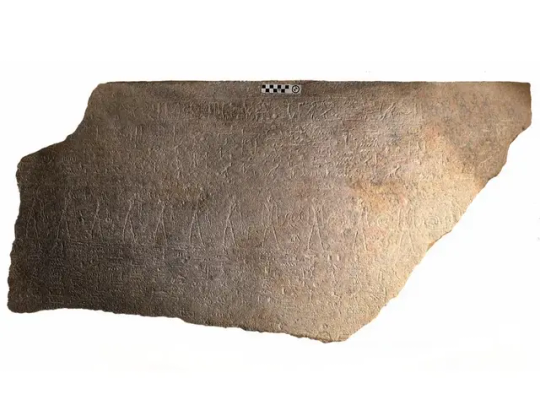
Ramses II’s Long-Lost Sarcophagus Has Finally Been Identified
An Egyptologist recently concluded that a fragment of an overlooked granite coffin bears the great pharaoh’s name.
Ramses II, a pharaoh who ruled in the 13th century B.C.E., is one of ancient Egypt’s best-known rulers. The 19th-Dynasty king expanded Egypt’s territory into modern-day Syria, fathered some 100 children and boasted one of the civilization’s most ornate coffins. But the carved granite sarcophagus built to house that coffin has never been identified—until now.
Frédéric Payraudeau, an Egyptologist at France’s Sorbonne University, recently re-examined a sarcophagus fragment found in the ancient necropolis of Abydos in 2009. At the time, experts posited that the engraved stone box had held the remains of two different people at different times, per a statement from the French National Center for Scientific Research. The second occupant was Menkheperre, a high priest who lived around 1000 B.C.E. But the first proved to be more difficult to pin down: Archaeologists only knew that they were a very high-ranking figure from the Egyptian New Kingdom, reports Live Science’s Jennifer Nalewicki.
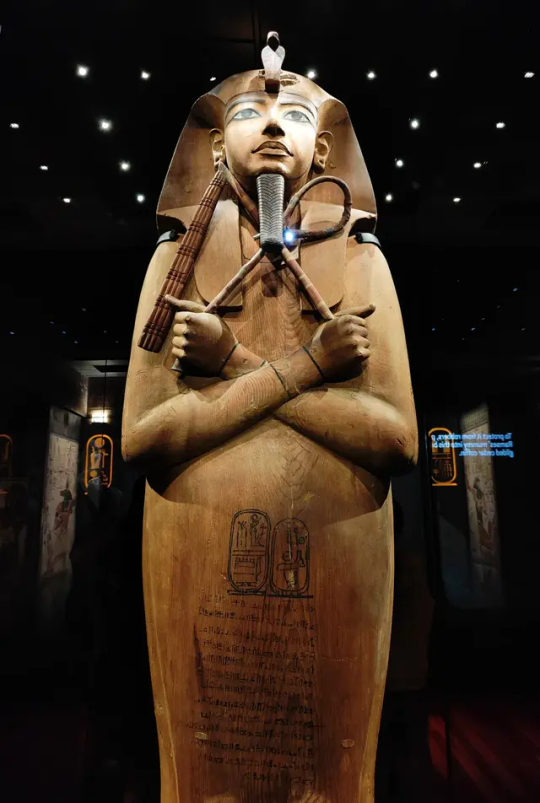
Ramses II's cedar coffin.
When Payraudeau studied the sarcophagus fragment’s inscriptions, including a previously obstructed and misidentified cartouche (an oval that typically encloses a royal name), he realized the hieroglyphs bore Ramses’ name. The scholar published his findings in the journal Revue D’Égyptologie.
Ramses’ reign lasted around 67 years, making it one of the ancient civilization’s longest. Dubbed the “builder pharaoh,” Ramses commissioned many temples throughout the region. As Payraudeau says in the statement, finding an ancient Egyptian site that isn’t marked with Ramses’ name is rare. The king even added his name to monuments built before his rule.
Ramses’ death in 1213 B.C.E. left a layered physical trail, thanks to multifaceted Egyptian entombing techniques and numerous pillagings of the Valley of the Kings, which held his and many other royal tombs. The pharaoh was buried in a gilded wooden coffin that was nested inside of an alabaster sarcophagus and a larger granite sarcophagus. Later, the coffin was stolen, the alabaster sarcophagus was shattered by looters and the granite sarcophagus—from which the fragment in question originated—was reused by Menkheperre.




As Payraudeau explains, the Valley of the Kings was plundered numerous times during ancient Egypt’s 19th Dynasty, an era of economic and social crises that led to scarcity, forcing even royals to reuse funerary objects created for their predecessors.
In 1881, Ramses’ mummy and coffin were discovered in a hiding place in the temple complex Deir el-Bahari, which housed the remains of 50 other members of the nobility, including the pharaoh’s father, Seti I, according to the Egypt Museum. Since then, the gold coffin and Ramses’ mummy have been exhibited at museums around the world. Whether the sarcophagus fragment, which is currently stored in Abydos, will one day go on display, too, remains unclear.
By Sonja Anderson.


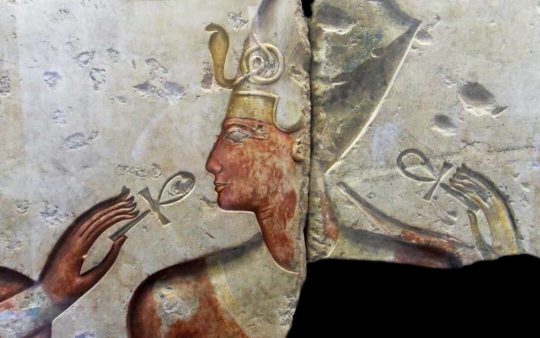
#Ramses II’s Long-Lost Sarcophagus Has Finally Been Identified#Ramses II#sarcophagus#ancient artifacts#archeology#archeolgst#history#history news#ancient history#ancient culture#ancient civilizations#ancient egypt#egyptian history#egyptian hieroglyphs#egyptian pharaoh#egyptian mythology#egyptian gods#egyptian art
82 notes
·
View notes
Text
Humans infecting animals infecting humans − from COVID-19 to bird flu, preventing pandemics requires protecting all species - Published Sept 4, 2024
I remember back in 2022, someone mocked me for worrying about zoonosis of new coivd strains. The science backs up my thoughts once again: We have to protect *everyone,* even critters, from disease to prevent future pandemics.
Authors Anna Fagre Veterinary Microbiologist and Wildlife Epidemiologist, Colorado State University
Sadie Jane Ryan Professor of Medical Geography, University of Florida
When the World Health Organization declared COVID-19 a pandemic on March 11, 2020, humans had been the only species with reported cases of the disease. While early genetic analyses pointed to horseshoe bats as the evolutionary hosts of SARS-CoV-2, the virus that causes COVID-19, no reports had yet surfaced indicating it could be transmitted from humans to other animal species.
Less than two weeks later, a report from Belgium marked the first infection in a domestic cat – presumably by its owner. Summer 2020 saw news of COVID-19 outbreaks and subsequent cullings in mink farms across Europe and fears of similar calls for culling in North America. Humans and other animals on and around mink farms tested positive, raising questions about the potential for a secondary wildlife reservoir of COVID-19. That is, the virus could infect and establish a transmission cycle in a different species than the one in which it originated.
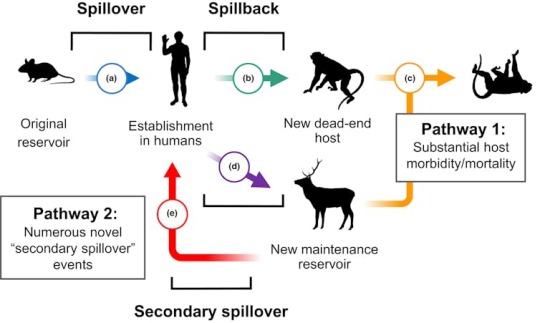
For example, spillback has been a long-standing threat to endangered great apes, even among populations with infrequent human contact. The chimpanzees of Gombe National Park, made famous by Jane Goodall’s work, have suffered outbreaks of measles and other respiratory diseases likely resulting from environmental persistence of pathogens spread by people living nearby or by ecotourists.
We are researchers who study the mechanisms driving cross-species disease transmission and how disease affects both wildlife conservation and people. Emerging outbreaks have underscored the importance of understanding how threats to wildlife health shape the emergence and spread of zoonotic pathogens. Our research suggests that looking at historical outbreaks can help predict and prevent the next pandemic.
Spillback has happened before Our research group wanted to assess how often spillback had been reported in the years leading up to the COVID-19 pandemic. A retrospective analysis not only allows us to identify specific trends or barriers in reporting spillback events but also helps us understand where new emergent threats are most likely.
We examined historical spillback events involving different groups of pathogens across the animal kingdom, accounting for variations in geography, methods and sample sizes. We synthesized scientific reports of spillback across nearly a century prior to the COVID-19 pandemic – from the 1920s to 2019 – which included diseases ranging from salmonella and intestinal parasites to human tuberculosis, influenza and polio.
We were also interested in determining whether detection and reporting bias might influence what’s known about human-to-animal pathogen transmission. Charismatic megafauna – often defined as larger mammals such as pandas, gorillas, elephants and whales that evoke emotion in people – tend to be overrepresented in wildlife epidemiology and conservation efforts. They receive more public attention and funding than smaller and less visible species.
Complicating this further are difficulties in monitoring wild populations of small animals, as they decompose quickly and are frequently scavenged by larger animals. This drastically reduces the time window during which researchers can investigate outbreaks and collect samples.
The results of our historical analysis support our suspicions that most reports described outbreaks in large charismatic megafauna. Many were captive, such as in zoos or rehabilitation centers, or semi-captive, such as well-studied great apes.
Despite the litany of papers published on new pathogens discovered in bats and rodents, the number of studies examining pathogens transmitted from humans to these animals was scant. However, small mammals occupying diverse ecological niches, including animals that live near human dwellings – such as deer mice, rats and skunks – may be more likely to not only share their pathogens with people but also to be infected by human pathogens.
COVID-19 and pandemic flu In our historical analysis of spillback prior to the COVID-19 pandemic, the only evidence we found supporting the establishment of a human pathogen in a wildlife population were two 2019 reports describing H1N1 infection in striped skunks. Like coronaviruses, influenza A viruses such as H1N1 are adept at switching hosts and can infect a broad range of species.
Unlike coronaviruses, however, their widespread transmission is facilitated by migratory waterfowl such as ducks and geese. Exactly how these skunks became infected with H1N1 and for how long remains unclear.
Shortly after we completed the analysis for our study, reports describing widespread COVID-19 infection of white-tailed deer throughout North America began surfacing in November 2021. In some areas, the prevalence of infection was as high as 80% despite little evidence of sickness in the deer.
This ubiquitous mammal has effectively become a secondary reservoir of COVID-19 in North America. Further, genetic evidence suggests that SARS-CoV-2 evolves three times faster in white-tailed deer than in humans, potentially increasing the risk of seeding new variants into humans and other animals. There is already evidence of deer-to-human transmission of a previously unseen variant of COVID-19.
There are over 30 million white-tailed deer in North America, many in agricultural and suburban areas. Surveillance efforts to monitor viral evolution in white-tailed deer can help identify emerging variants and further transmission from deer populations into people or domestic animals.
Investigations into related species revealed that the risk of spillback varies. For instance, white-tailed deer and mule deer are highly susceptible to COVID-19 in the lab, while elk are not.
H5N1 and the US dairy herd Since 2022, the spread of H5N1 has affected a broad range of avian and mammalian species around the globe – foxes, skunks, raccoons, opossums, polar bears, coyotes and seals, to name a few. Some of these populations are threatened or endangered, and aggressive surveillance efforts to monitor viral spread are ongoing.
Earlier this year, the U.S. Department of Agriculture reported the presence of H5N1 in the milk of dairy cows. Genetic analyses point to an introduction of the virus into cows as early as December 2023, probably in the Texas Panhandle. Since then, it has affected 178 livestock herds in 13 states as of August 2024.
How the virus got into dairy cow populations remains undetermined, but it was likely by migratory waterfowl infected with the virus. Efforts to delineate exactly how the virus moves among and between herds are underway, though it appears contaminated milking equipment rather than aerosol transmission, may be the culprit.
Given the ability of influenza A viruses such as avian flu to infect a broad range of species, it is critical that surveillance efforts target not only dairy cows but also animals living on or around affected farms. Monitoring high-risk areas for cross-species transmission, such as where livestock, wildlife and people interact, provides information not only about how widespread a disease is in a given population – in this case, dairy cows – but also allows researchers to identify susceptible species that come into contact with them.
To date, H5N1 has been detected in several animals found dead on affected dairy farms, including cats, birds and a raccoon. As of August 2024, four people in close contact with infected dairy cows have tested positive, one of whom developed respiratory symptoms. Other wildlife and domestic animal species are still at risk. Similar surveillance efforts are underway to monitor H5N1 transmission from poultry to humans.
Humans are only 1 part of the network The language often used to describe cross-species transmission fails to encapsulate its complexity and nuances. Given the number of species that have been infected with COVID-19 throughout the pandemic, many scientists have called for limiting the use of the terms spillover and spillback because they describe the transmission of pathogens to and from humans. This suggests that disease and its implications begin and end with humans.
Considering humans as one node in a large network of transmission possibilities can help researchers more effectively monitor COVID-19, H5N1 and other emerging zoonoses. This includes systems-thinking approaches such as One Health or Planetary Health that capture human interdependence with the health of the total environment.
#covid#mask up#pandemic#covid 19#wear a mask#coronavirus#sars cov 2#public health#still coviding#wear a respirator
49 notes
·
View notes